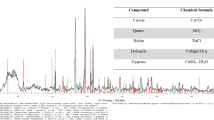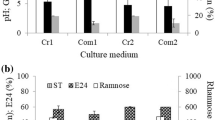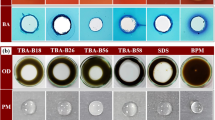Abstract
Pseudomonas aeruginosa PACL strain, isolated from oil-contaminated soil taken from a lagoon, was used to investigate the efficiency and magnitude of biosurfactant production, using different waste frying soybean oils, by submerged fermentation in stirred tank reactors of 6 and 10 l capacities. A complete factorial experimental design was used, with the goal of optimizing the aeration rate (0.5, 1.0, and 1.5 vvm) and agitation speed (300, 550, and 800 rpm). Aeration was identified as the primary variable affecting the process, with a maximum rhamnose concentration occurring at an aeration rate of 0.5 vvm. At optimum levels, a maximum rhamnose concentration of 3.3 g/l, an emulsification index of 100%, and a minimum surface tension of 26.0 dynes/cm were achieved. Under these conditions, the biosurfactant production derived from using a mixture of waste frying soybean oil (WFSO) as a carbon source was compared to production when non-used soybean oil (NUSO), or waste soybean oils used to fry specific foods, were used. NUSO produced the highest level of rhamnolipids, although the waste soybean oils also resulted in biosurfactant production of 75–90% of the maximum value. Under ideal conditions, the kinetic behavior and the modeling of the rhamnose production, nutrient consumption, and cellular growth were established. The resulting model predicted data points that corresponded well to the empirical information.



Similar content being viewed by others
References
Makkar, R. S., & Cameotra, S. S. (2002). Applied Microbiology and Biotechnology, 58, 428–34.
Banat, I. M., Samarah, N., Murad, M., Roene, R., & Banerju, S. (1991). Applied Microbiology and Biotechnology, 7, 80–88.
Lin, S. C., Sharma, M. M., & Georgiou, G. (1996). Biotechnology, 9, 138–145.
Nitschke, M., & Pastore, G. M. (2002). New Journal of Chemistry, 25, 772–776.
Reis, F. A. S. L., Servulo, E. F. C., & França, F. P. (2004). Applied Microbiology and Biotechnology, 115, 899–912.
Cameotra, S. S., & Makkar, R. S. (1998). Applied Microbiology and Biotechnology, 50, 520–529.
Francy, D. S., Thomas, J. M., Raymond, R. L., & Ward, C. H. (1991). Journal of Industrial Microbiology & Biotechnology, 8, 237–246.
Mulligan, C. N. (2004). Environmental Pollution, 133, 183–198.
Syldatk, C., Lang, S., & Wagner, F. (1985). Zeitschrift für Naturforsch, 46, 51–60.
Bodour, A. A., Drees, K. P., & Maier, M. R. (2003). Applied and Environmental Microbiology, 69, 3280–3287.
Ochsner, A. U., Hembach, T., & Fiechter, A. (1996). Advances in Biochemical Engineering, Biotechnology, 53, 89–119.
Haba, E., Espuny, M. J., Buquets, M., & Manresa, A. (2000). Journal of Applied Microbiology, 88, 379–387.
De Lima, C. J. B., De França, F. P., Sérvulo, E. F. C., Resende, M. M., & Cardoso, V. L. (2007). Applied Biochemistry and Biotechnology, 136–140, 463–470.
Santos, A. S., Sampaio, A. P. W., Vasquez, G. S., Santa Anna, L. M., Pereira, N., & Freire, D. M. G. (2002). Applied Biochemistry and Biotechnology, 98–100, 1025–1035.
Rainer, B. W. (1990). Chemical and Biochemical Engineering, 4, 185–196.
Marquardt, D. W. (1963). Journal of the Society for Industrial and Applied Mathematics, 11, 431–441.
Gill, S. (1951). Proceedings of the Cambridge Philological Society, 47, 96–108.
Bailey, J. E., & Ollis, D. F. (1986). Biochemical engineering fundamentals (Paperback) (p. 4042nd ed.). Singapore: McGraw-Hill.
Luedeking, R., & Piret, E. L. (1959). Journal of Biochemical and Microbiological Technology and Engineering, 1, 393–412.
APHA. American Public Health Association. (1989). Standard Methods for the Examination of Water and Wastewater. 17th ed (pp. 123). Washington DC.
APHA. American Public Health Association. (1989). Standard Methods for the Examination of Water and Wastewater. 17th ed (pp.151). Washington DC.
Normas Analíticas do Instituto Adolfo Lutz (1985). Métodos Químicos e Físicos para Análises de Alimentos, 1, 317–319.
Rahman, K. S. M., Rahaman, T. J., Mcclean, S., Marchant, R., & Banat, I. M. (2002). Biotechnology Progress, 18, 1277–1281.
Cooper, D. G., & Goldenberg, B. G. (1987). Applied and Environmental Microbiology, 42, 224–229.
Reis, F. A. S. L., Sérvulo, E. F. C., & De França, F. (2004). Applied and Environmental Microbiology, 899(912), 113–116.
Mercadé, M. E., Manresa, A., Robert, M., Espuny, M. J., Andrés, C., & Guinea, J. (1993). Bioresource Technology, 43, 1–6.
Benicasa, M., Contiero, J., Manresa, M. A., & Moraes, I. O. (2002). Journal of Engineering, 54, 283–288.
Rosen, M. J. (1989). Surfactants and interfacial phenomena p. 431. New York, USA: Wiley.
Banat, I., Makkar, R., & Cameotra, S. (2000). Applied Microbiology and Biotechnology, 53, 495–508.
Jeff Wu, C. F., & Hamada, M. (2000). Experiments: Planning, analysis, and parameter design optimization. New York: Wiley.
Tyagi, V. K., & Vasishtha, A. K. (1996). Journal of the American Oil Chemists Society, 73, 499–506.
Waltking, A. E., & Wessels, H. (1981). Journal of the Association Office Analytical Chemists, 64, 1329–1330.
Nawar, W. W. (1996). Food chemistry. New York: M. Dekker. 3, 225–319.
Damy, P. C., & Jorge, N. (2003). Brazilian Journal of Food Technology, 6, 251–257.
Desai, J. D., & Banat, I. M. (1997). Microbiology and Molecular Biology Reviews, 61, 47–64.
Acknowledgements
The authors wish to thank Prof. Dr. Dália dos Prazeres Rodrigues (Curator of Instituto Oswaldo Cruz, RJ, Brazil) for carrying out the bacterial strain identification. This work was supported by Coordenação de Aperfeiçoamento de Pessoal de Nível Superior (CAPES), Ministério da Educação, Brazil.
Author information
Authors and Affiliations
Corresponding author
Rights and permissions
About this article
Cite this article
de Lima, C.J.B., Ribeiro, E.J., Sérvulo, E.F.C. et al. Biosurfactant Production by Pseudomonas aeruginosa Grown in Residual Soybean Oil. Appl Biochem Biotechnol 152, 156–168 (2009). https://doi.org/10.1007/s12010-008-8188-1
Received:
Accepted:
Published:
Issue Date:
DOI: https://doi.org/10.1007/s12010-008-8188-1




